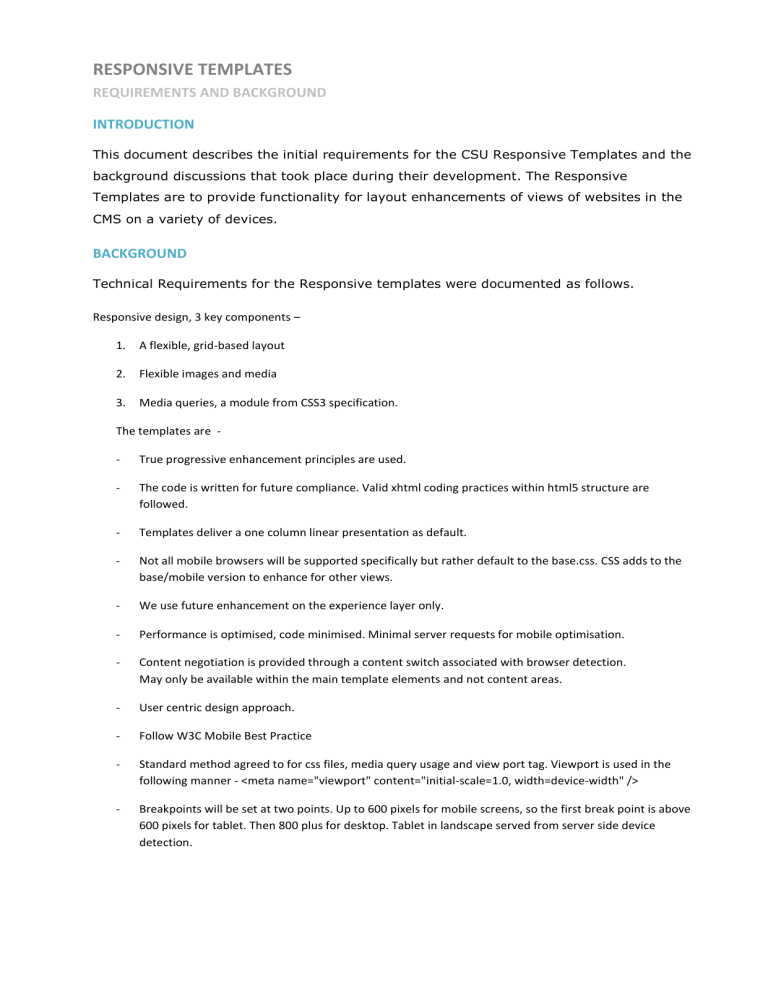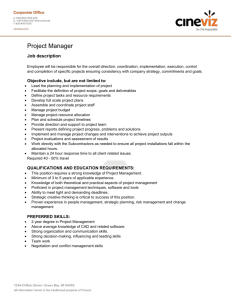RWD Requirements and Background

RESPONSIVE TEMPLATES
REQUIREMENTS AND BACKGROUND
INTRODUCTION
This document describes the initial requirements for the CSU Responsive Templates and the background discussions that took place during their development. The Responsive
Templates are to provide functionality for layout enhancements of views of websites in the
CMS on a variety of devices.
BACKGROUND
Technical Requirements for the Responsive templates were documented as follows.
Responsive design, 3 key components –
1.
A flexible, grid-based layout
2.
Flexible images and media
3.
Media queries, a module from CSS3 specification.
The templates are -
True progressive enhancement principles are used.
The code is written for future compliance. Valid xhtml coding practices within html5 structure are followed.
Templates deliver a one column linear presentation as default.
Not all mobile browsers will be supported specifically but rather default to the base.css. CSS adds to the base/mobile version to enhance for other views.
We use future enhancement on the experience layer only.
Performance is optimised, code minimised. Minimal server requests for mobile optimisation.
Content negotiation is provided through a content switch associated with browser detection.
May only be available within the main template elements and not content areas.
User centric design approach.
Follow W3C Mobile Best Practice
Standard method agreed to for css files, media query usage and view port tag. Viewport is used in the following manner - <meta name="viewport" content="initial-scale=1.0, width=device-width" />
Breakpoints will be set at two points. Up to 600 pixels for mobile screens, so the first break point is above
600 pixels for tablet. Then 800 plus for desktop. Tablet in landscape served from server side device detection.
Mobile version requirements
Menu item to be a push down or overlay solution which is also available at the footer.
Global navigation bar is to be removed and accessed from an icon bar below branding.
Mobile /Desktop switch is also available from an icon.
Search within the context is available from an icon.
Menu of the site is available from a text based icon titled “Menu” styled with CSS.
When implementing to the CMS a no index metadata field will be added to be turned on or off as required.
Abbreviated CSU logo use for the mobile version.
JQuery Mobile - Investigation of techniques to display and hide menus. Assess overheads and download size.
User testing need to be conducted. Face to face, impromptu sessions and Loop 11 sessions. TBA
MOBILE BEST PRACTICE
HTML
HTML comments around important sections (eg body).
Use semantic markup
Meaningful names for classes and ids
Minimise markup
Indentation
Code validated with w3c tool and HTML codesniffer
Helpful title element
Comment where external JS is included (makes parse files readable)
CSS
Use of a CSS reset
Meaningful sections and commenting
Indentation
Minified where a.) CSS is large and intended for mobile, and b.) CSS is still manageable (hardly ever)
Use a CSS linter on the text editor to catch any known issues
Unix line breaks (not /r/n for windows)
Use classes in preference to IDs, but not at the cost of creating confusing CSS.
CSS base64 encoded images to reduce http requests: background: url(data:image/png;base64,%globals_asset_file_contents:XXXXX^base64encode%);
CSS ‘breakpoints’ & percentage widths based on ((mockup_width/target_screen_width)*100);
BREAKPOINTS
320 (iPhone, Android and blackberry)
720 (fits smack in the middle of minor breakpoints)
1024 (Some desktop, iPad, many notebooks)
MINOR BREAKPOINTS
240 (Some android, many blackberry)
360 (Symbian touch)
480 (iPhone, Android, some Symbian)
600 (some tablets, e-readers)
640 (Some Symbian touch)
768 (iPad, some tablets, old desktops)
800 (some tablets, galaxy note portrait)
JAVASCRIPT
Use javascript libraries only when required
Avoid polluting the global namespace where possible
jQuery is Squiz’s preferred JS library
Minify where a.) JS is large and intended for mobile, and b.) JS is still manageable.
MOBILE
Optimise images for mobile devices
Device detection on screen width rather than device user agent string for responsive designs.
Give users an “opt out” where possible
Avoid “expensive” javascript functions (Device CPU)
If the goal is to provide users with a tailored mobile content then a separate site with it’s own domain may have more merit than responsive. This is where content adaption via apache may be considered very useful.
Give users the quickest possible path to the information
Be mindful of bandwidth and data limitations of mobile users
Validate through mobile ok checker. Very difficult to get a full pass but we should do our best.
Use Modernizer for mobile feature detection (eg, touch)
MATRIX DESIGN/DESIGN AREA BEST PRACTICE
For new sites design asset created beneath the site asset.
Shares the same URL as the site. Removes the need to apply the URL to the designs folder.
Limit the amount of design areas. Less design areas reduce the amount of assets created by the design and make it easier to manage. Look for savings by nesting content or using simpler design areas.
Limit the amount of separate designs created. Potentially designs can be created with a single design asset (home, inside etc) and differentiated by customisation.
Grouping design related content
Limit design customisations (see same reason for design areas)
Reduce separate http requests as much as possible. Use sprites for icons where appropriate.
Limit requests for external files like javascript and css.
Define the design areas we are going to use for each of the sections and make some decisions:
Is it going to be dynamic?
How often will it be changed and by who (technical author)?
Should it be cached?
Start implementing the design areas from known examples to make things faster (grabbing previous designs or manuals examples and manipulating is helpful).
MOBILE SPECIFIC AREAS
What kind of content do we need to transform for mobile devices:
Why are we transforming it (purpose)?
Does it need to be done dynamically?
Do we need to refine the design for mobile? (minification, reducing http requests).
Asset attributes, div content & metadata contextable on each asset. Apart from this contextable information is on a per-asset basis.
(Context support to be added to Edit+ in the next release of CMS Nov 5 2012)
Using paint layouts and conditional keywords to alter the output of matrix based on regular expression matches against user agent string.
Problems with user agent string detection include, but not limited to:
Constantly evolving mobile device market
Inconsistent application of user agent headers.
Some devices do not report themselves as mobile prohibiting the use of specified ‘handheld’ attributes for CSS.
High maintenance overhead trying to manage the device headers
Difficult to provide users with the option to ‘opt out’
Context support means maintaining separate copies of some information which leads to duplicate data.
Editors have to be highly aware of the context system, which context they are editing in and which parts of Matrix information will be contexted. Global edits can be inadvertent and dangerous.
Client-side adaption. JS support on devices is quite high. We deal with screen resolutions instead of individual devices. Media queries/attributes allow scaling to device screen resolution. The only real con is devices that don’t support javascript, or have ‘faux’ javascript support like the older blackberry. Need to be mindful about running javascript ‘too often’, we want to be kind to battery life.
But what about higher resolution devices like Mac Retina/iPhone 4 display? Higher res images can be used in the same pixel space but requires the use of the background-size CSS3 property. This property can restrict the size of a higher resolution image into smaller dimensions without a loss in clarity. Don’t use this by default. IE 8 won’t support background-size and it causes the user to download a much larger version of the file. If a high res version of the image is required then content adaption should be used to specifically target the device that is intended for.



